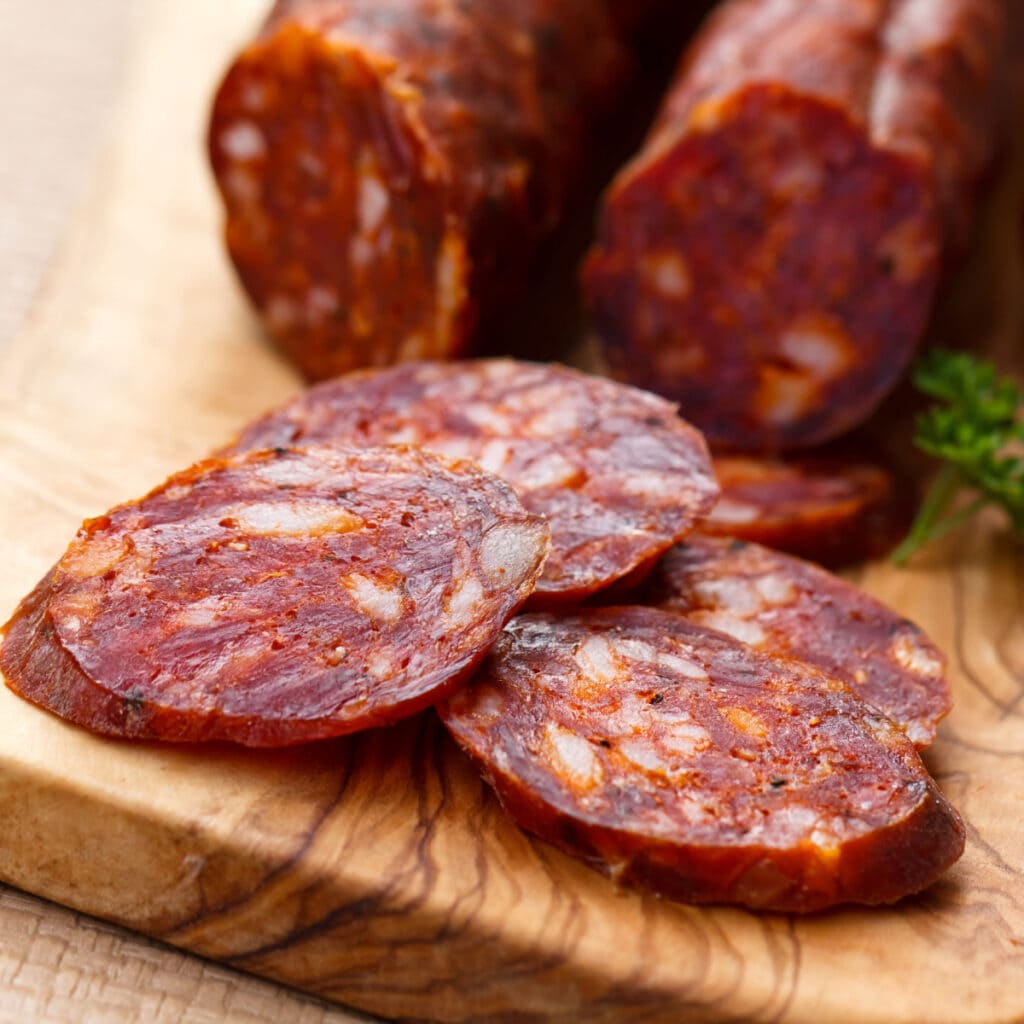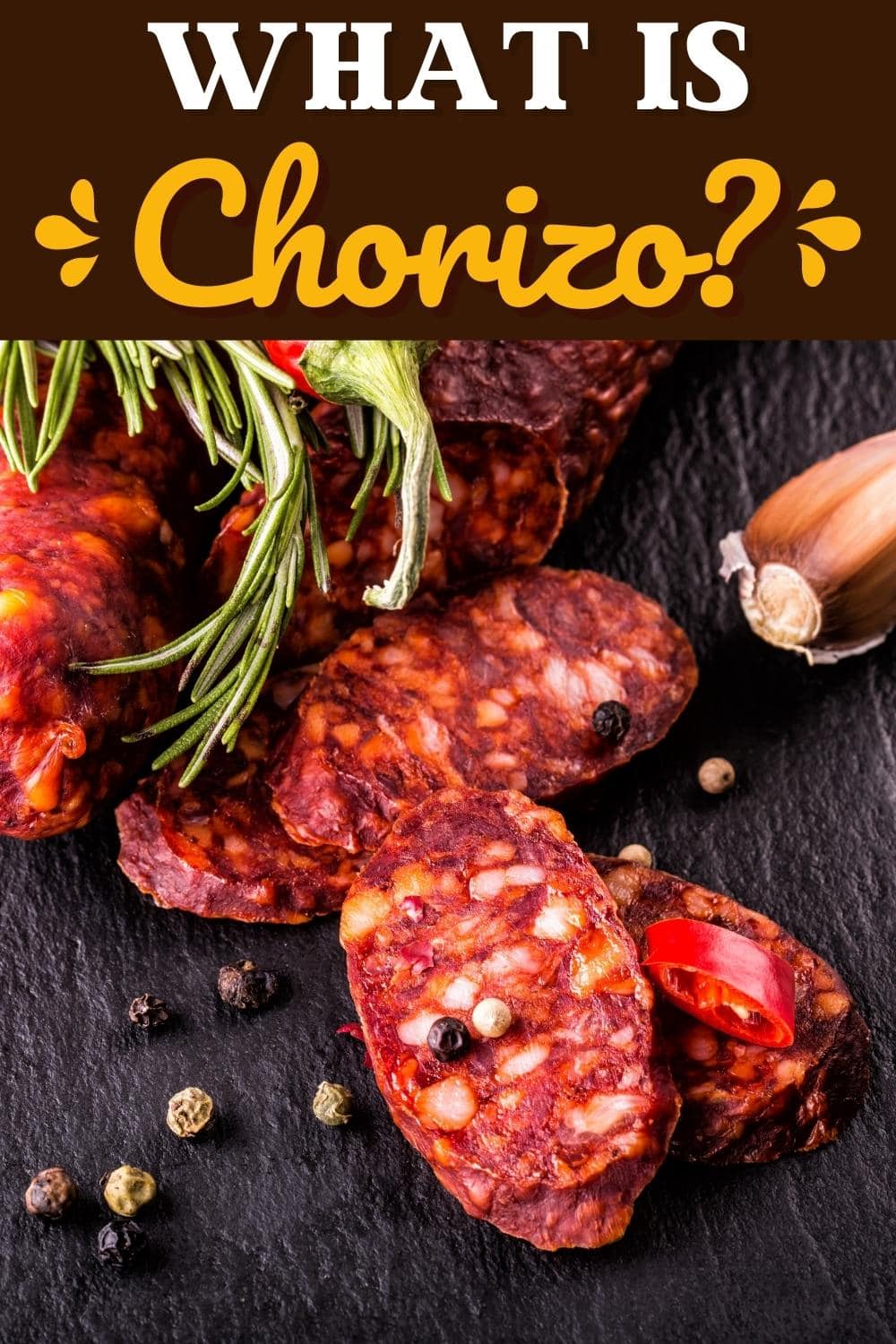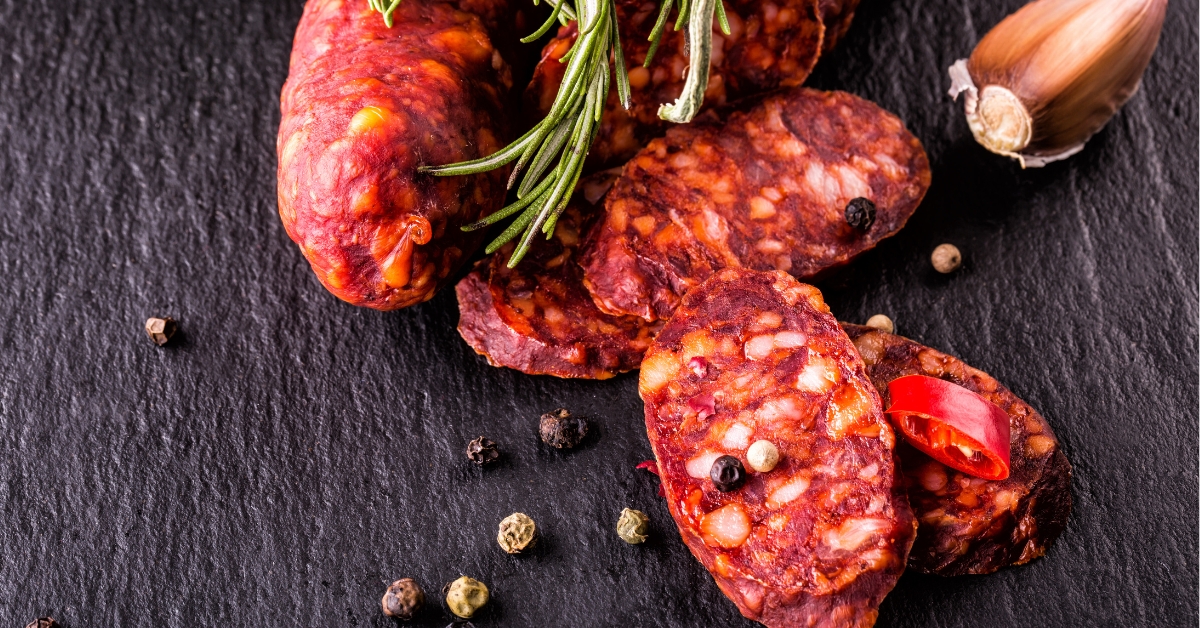You’ve probably tried this flavorful meat before, but have you ever wondered, what is chorizo?
I know I have. So I decided to find out for the both of us!

Chorizo is one of the most enigmatic ingredients in any pantry.
Closely related to sausage yet infinitely more mysterious, its bold flavor commands attention in any dish.
This spicy sausage-like meat has long been a staple of Mexican and Spanish cuisines.
And the piquant flavor serves as a welcome element to many classic Spanish recipes, like paella.
But while it may be coveted by chefs around the world, the pre-cooked variety can be quite intimidating.
For those brave enough to tackle this fiery challenge, chorizo might just turn into their new favorite ingredient!
What Is Chorizo?
Chorizo is a type of cured or smoked sausage which originates from the Iberian Peninsula and is popular all over the world.
It usually comes in a cylindrical shape. It can be red (because of being seasoned with paprika) or brown (due to garlic).
Chorizo has an intense flavor, and its main ingredients are pork, fat, salt, smoked paprika, and garlic.
This type of sausage can be eaten alone as a snack, but it is also used to season dishes like stews, soups, or scrambled eggs.
In general, chorizo should be refrigerated after opening and consumed within a couple of days.
It can also be frozen to extend its shelf life.
As for chorizo recipes, it’s best cut into small pieces and fried in oil until browned.

What Is Chorizo Made Out Of?
It is made with different types of ground meat, herbs, and spices, such as smoked paprika, garlic, and oregano.
Depending on the region, chorizo may be either fresh or cured.
Fresh chorizo usually contains a higher fat content and needs to be cooked before consumption.
Cured chorizo can be eaten raw, but it typically requires curing for at least 2 months before it’s ready to eat.
The flavor of chorizo varies from mild to spicy depending on how much chili pepper is used in its preparation.
Chorizo can be used for cooking many dishes, such as scrambled eggs, pizzas, bruschetta, tacos, and even salads.
It’s also a popular topping for burgers, sandwiches, and hot dogs.
With its intense flavor and aroma, chorizo is an ideal ingredient to add an extra kick to any recipe.
It is also an excellent source of protein and vitamins that can help bolster your diet.
There are two main kinds of chorizo, Mexican and Spanish.
Even though people often confuse them, they’re definitely not the same. Let’s explore the key differences.
Spanish Chorizo vs. Mexican Chorizo
When it comes to Spanish and Mexican chorizo, there’s a lot of sizzling confusion.
Sure, they both look similar. They’re links of red sausage typically wrapped in parchment paper.
But the similarities end there.
The main difference between these two types of porky sausages lies in the way they’re made and their flavor profiles.
Spanish chorizo is made from pork shoulder that’s been cured with smoked paprika, salt, garlic, and other spices.
It makes a dry version that’s often eaten as-is or sliced up into tapas dishes.
It has an edible sausage casing, unlike its counterpart.
The result is a semi-firm texture with a smoky aroma and bold spicy flavors.
On the other hand, Mexican chorizo is a raw, crumbly sausage made from pork shoulder or ground beef, and garlic.
It also includes other spices like chili pepper, cumin, and oregano. The casing should be removed before consumption.
It’s usually cooked up in dishes rather than eaten as-is, resulting in a juicy texture that packs a deliciously spicy punch. yum!
Both of them are very fragrant and flavorful.
You can use them both in most Latin and Spanish dishes, but you can also use them to spice up recipes from other cuisines.
Overall, both are really versatile ingredients that are a staple in my pantry.

How to Cook Mexican Chorizo
Cooking with chorizo is a delicious, spicy way to add flavor to your favorite dishes.
Whether you’re making a paella or an omelet, adding some chorizo into the mix can be just the thing to take it over the top.
Here’s how to make cooking with chorizo as easy and tasty as possible.
Start by picking out the perfect chorizo for your dish.
There are lots of different types of chorizo available, from Mexican-style to Spanish-style.
Do some research and choose one that will go well with whatever you’re making.
Once you have your chorizo chosen, get ready for some serious sautéing.
Heat up some olive oil in a skillet, then add in the chorizo and let it sizzle for about five minutes or until it starts to brown.
Now, it’s time to get creative!
For breakfast dishes like omelets, diced potatoes, onions, and bell peppers work great with chorizo.
For lunch or dinner dishes, why not try adding other vegetables such as asparagus or mushrooms?
If you want something a little heartier, try mixing your chorizo with beans or rice.
And if you really want to kick things up a notch, consider adding some heat by sprinkling on some chili flakes or red pepper powder.
The combination of flavors will be sure to tantalize your tastebuds.
Of course, no meal is complete without an accompaniment.
The great thing about cooking with chorizo is that it pairs well with everything from salads to potatoes to tacos.
So pick something that you think will complement the flavors in your dish and you’re all set.

Where to Buy Chorizo
Looking for some chorizo? You’ve come to the right place!
Whether you’re in the mood for a spicy Spanish-style chorizo or a mild Mexican version, we’ve got you covered.
So where should you buy your chorizo? Here are my top recommendations:
The first place I recommend is your local grocery store.
Most supermarkets have both types of chorizo and often carry more than one brand.
You can choose what fits your tastes and budget best.
Many people prefer to purchase their groceries online these days.
But it’s worth visiting in person if possible so that you can ask questions and get helpful advice from the staff if needed.
Plus, it’s always nice to support local businesses when it comes to food.
Another great place to buy chorizo is at a specialty Latin market.
Here, you’ll find plenty of varieties and brands, as well as other unique ingredients that you may not be able to find elsewhere.
Not only that, but most Latin markets also feature a butcher counter where they will custom-make your chorizo for your specific needs.
Finally, if you’re looking for something really special, like organic or artisanal chorizo, then an online retailer may be the best option.
This way you can get exactly what you want with minimal effort.
Plus, it’s often more cost-effective than buying in person depending on the size of the order.
Of course, make sure to read the reviews and check that the company is reputable before you purchase.
No matter where you buy your chorizo, be sure to read up on how to store and handle it properly so that it stays fresh and delicious.




